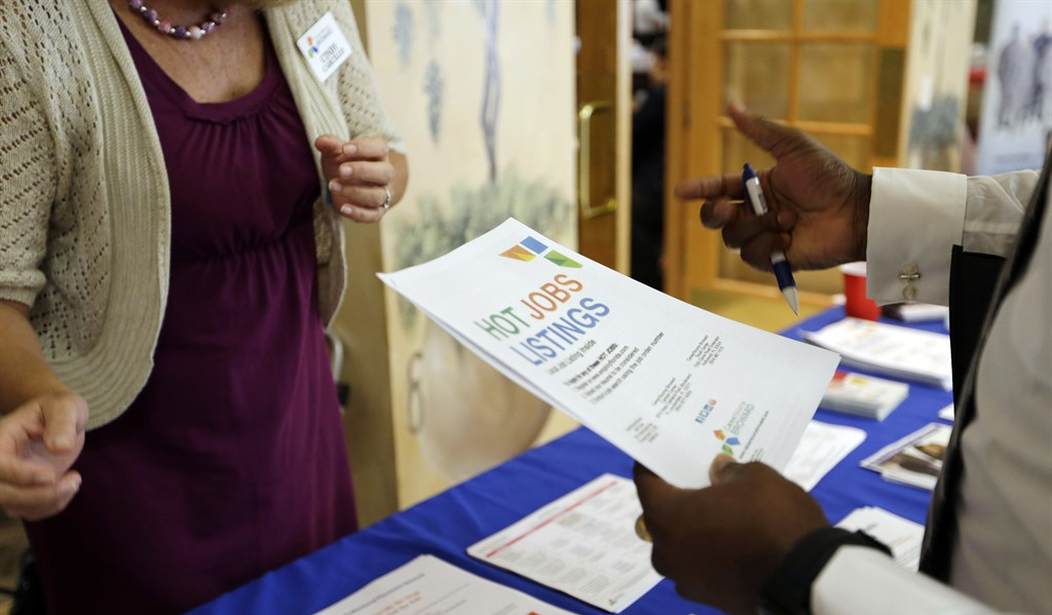For once, the official jobs report from the Bureau of Labor Statistics handily beat the ADP precursor. The US economy added a rather robust 222,000 jobs in June, a sharp increase over two less-than-stellar months preceding it. The BLS also upwardly revised April and May to add an additional 47,000 jobs, bringing the three-month average to 194,000:
Total nonfarm payroll employment increased by 222,000 in June, and the unemployment rate was little changed at 4.4 percent, the U.S. Bureau of Labor Statistics reported today. Employment increased in health care, social assistance, financial activities, and mining.
In June, the unemployment rate, at 4.4 percent, and the number of unemployed persons, at 7.0 million, were little changed. Since January, the unemployment rate and the number of unemployed are down by 0.4 percentage point and 658,000, respectively. …
The change in total nonfarm payroll employment for April was revised up from +174,000 to +207,000, and the change for May was revised up from +138,000 to +152,000. With these revisions, employment gains in April and May combined were 47,000 more than previously reported. Monthly revisions result from additional reports received from businesses and government agencies since the last published estimates and from the recalculation of seasonal factors. Over the past 3 months, job gains have averaged 194,000 per month.
All of this is better news than in recent reports. In order to maintain current employment ratios against population growth, the US economy needs to add at least 125,000 jobs a month for a maintenance rate. June’s results provide evidence of moderate gains against joblessness, as do the upward revisions applied to April. The May results still don’t stack up as much more than a maintenance level of job creation, but now both May and the dreadful March results look like outliers of a somewhat cheery job-creation trend in 2017:

Republicans promised a more robust job-creation trend, but they also have not put much of their economic plan into place yet, either.
The U-3 unemployment rate went up a tenth of a point to 4.4% from May, but that appears to be mainly a rounding artifact and a reflection of labor-force expansion. The civilian labor force went up by 361,000, almost reversing the significant drop seen in May of 429,000, while the number of those not in the labor force dropped by 170,000. Both the participation and employment-population ratios went up a tenth of a point, an improvement while still remaining near lows of recent decades. The U-6 unemployment rate — which is more comprehensive — actually went up two-tenths of a point, but again, that may reflect a larger workforce rather than a lack of job creation.
While the goods-producing sector had its best month of the quarter, most of the gains still came in the service sector. The biggest winner was in health care and social assistance (59,100 jobs), followed by temporary help services (45,000). The latter might indicate good news about future growth, although it’s not far off from May’s 35K and identical to April’s 45K. Businesses will often add temporary jobs for expansion first, and then convert them to regular employment when demand firms up.
The AP’s Christopher Rugaber sounds a cheery note about the job expansion, but a little less so about the US economy in general:
Home sales are chugging along, though a shortage of properties for sale suggests that the pace of purchases could flag. The number of people signing contracts to buy homes — step that precedes final sales by a month or two — has fallen for three straight months.
And auto sales are slowing from last year’s record pace, causing some automakers to cut jobs.
At the same time, surveys of manufacturing and service companies indicate that growth in both sectors may be accelerating. Factory activity is expanding at the fastest pace in three years, the Institute of Supply Management, a trade group of purchasing managers, found.
The economy grew at just a 1.4 percent annual rate in the first three months of the year, below even the sluggish 2 percent average pace in the eight years since the recession ended. But most economists have forecast that growth rebounded in the April-June quarter to an annual rate of 2.5 percent or higher.
The job-creation trend seems to show employers anticipating a stronger Q2 and Q3, but not explosive growth. Employment usually lags growth, though, which is why the May results were disconcerting. It seems that employers in June went back to a mildly optimistic outlook, and so did workers re-entering the market, but both are still waiting for the new administration and Congress to deliver on their economic agenda.







Join the conversation as a VIP Member